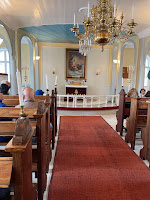Our last stop in Greenland was Qaqortoq (ka KOR tok). In fact, the town was very quaint, that is quaint Qaqortoq (try saying that rapidly five times in a row!).
 |
| Qaqortoq |
Located in southern Greenland near Cape Thorvaldsen, it is the most populous town in southern Greenland with 3050 inhabitants (2020). The area around Qaqortoq has been inhabited by various cultures since around 4300 years ago. Danish traders founded the present-day town as a trading post in 1775.
 |
| Fish market salmon |
Qaqortoq’s economy is primarily based on educational and administrative services, but fish and shrimp processing, tourism, tanning and fur production are important contributors. The town became a major center for the saddleback seal trade and today remains the home of the Great Greenland Sealskin Tannery, the only tannery in Greenland and the primary sealskin purchaser.
 |
| Need some seal? |
The town is connected to other west coast towns by air and ferry services.
Rain was in the weather forecast, and it started raining as we were tendering over to Qaqortoq’s dock. Fortunately, we had an umbrella. We met our guide, a feisty, local businesswoman who pointed out the 3 fishing boats that she owned. Depending on the season, she fished for cod, Atlantic salmon, and caviar.
 |
| Qaqortoq harbor |
She was quick to point out that once her products left Greenland the prices became greatly inflated, while she did all the work for little return. And she had absolutely no love for Greenpeace who repeatedly try to interfere with local subsistence fishing activities.
We went into the local fish market which turned out to be more than just a fish market. Cod and salmon were the fish that were on display. Some were whole fish and others had been gutted, but all were really nice specimen. In addition to the fish, the shop had reindeer that had been killed and sold to the market by local hunters. Also available for purchase was saddleback seal meat cuts which Capt. Larry thought would make some pretty good flipper stew!
 |
| Inside the old church |
He could only guess what a seal’s head would be used for.
Leaving the market, we went into the “old” church to get out of the rain and listen to our guide provide some information on Qaqortoq. One of the disturbing things that she related to us was the high rate of suicide being committed by young members of the community.
 |
| New church with altarpiece motifs |
In fact, Greenland has the highest suicide rate in the world. The Borgen Project reported in 2016 (latest data?) that the global average annual suicide rate was 16 persons per 100,000, but in Greenland the rate was 82 persons per 100,000. Additionally, suicide is not evenly distributed across Greenland’s population with teenagers and young adults at the highest risk and the prevalence three times higher among 20-24 year-olds than 25-65 year-olds. Also, 23% of teenagers and young adults report that they have self harmed.
 |
| Sealskin covered kneelers |
Having attended some recent funerals, we could tell that this was a very upsetting subject for our guide.
Leaving the old church, we walked up a hill where we could catch a view of the town’s cemetery at the foot of a mountain. Also at the top was the “new” Gertrud Rasch’s Church. The church was consecrated in 1973 and named after the wife of the Danish missionary who built the old church, Hans Egede. The church was built to accommodate the growing population of Qaqortoq.
 |
| Cemetery in distance |
What we thought was really unique to the church was the motifs of the altarpiece which were based on the flora of South Greenland and the sealskin-covered kneeling pads. Our guide spent some time describing some of the unique aspects of church ceremonies and the importance of religion to the Qaqortoq people.
We left the church and went into the town’s supermarket.
 |
| Qaqortoq supermarket |
Like the supermarket in Nanortalik, it had a little bit of everything, even including complete sets of bedroom furniture and a full line of household appliances.
 |
| Greenlanders love ketchup! |
It was definitely set up for one-stop shopping! Next we passed a building that housed the bank and post office, sitting adjacent to what looked like a really new hotel. The hotel had a four-star rating, and in its parking lot, atop a large boulder, was an outdoor statue of a sealskin boot, placed there to honor the importance of the sealing and sealskin tanning activities to the town.
 |
| Hotel and sealskin boot |
Back aboard the ship we had some lunch. Around midafternoon we weighed anchor and got underway. No sooner had we started than the captain announced that in about an hour’s time we would be cruising into a major storm system that was forecast to produce winds in excess of 45 mph and seas of up to 15 feet. He noted that these conditions would produce a lumpy and uncomfortable ride well into the early morning hours, and cautioned passengers to take extra precautions to protect themselves. Almost on cue, conditions went south as predicted. We were able to have dinner with a really fun kiwi couple, but spent the rest of the evening in our room as the ship’s activities were canceled for the evening.

No comments:
Post a Comment